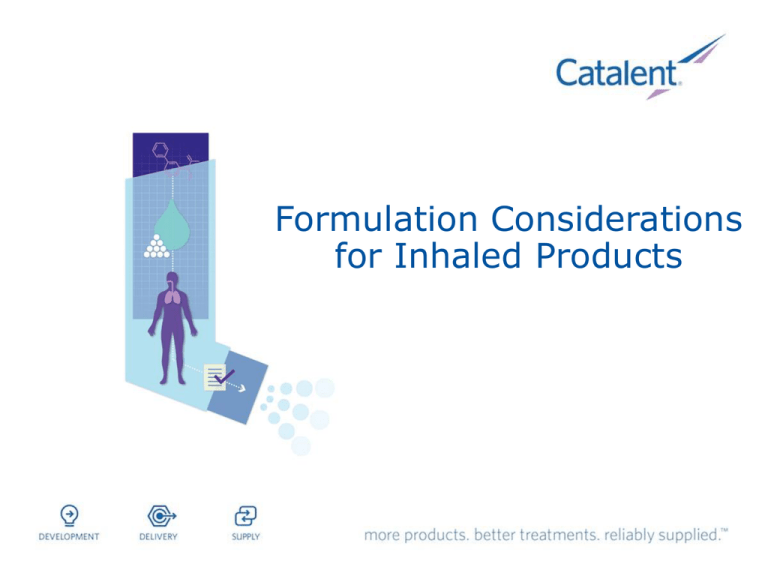Formulation Considerations of Inhaled Products
advertisement

Formulation Considerations for Inhaled Products Formulation Considerations of Inhaled Products Inhalation Therapy Nebulizers and Formulations Dry Powder Inhalers and Formulations Metered Dose Inhalers (MDI) and Formulations Conclusions 07/20/2012 Formulation Considerations of Inhaled Products 1 Inhalation Therapy • Inhalation Therapy Refers to Direct Delivery of the Medications to/via the Lungs by Inhalation — Regional Therapeutic Effect • • — Respiratory Disease — Asthma and Chronic obstructive pulmonary disease (COPD) Pulmonary Hypertension Systemic Therapeutic Effect • Migraine — Ergotamine Tartrate • Parkinson’s Disease — Apomorphine Hydrochloride Diabete Mellitus — Inhaled Insulin • • Advantages of Inhalation Therapy — Delivery of the Medications Directly to the Action Site — Rapid Onset — Enhanced Bioavailability by Avoiding First Pass Effect 07/20/2012 Formulation Considerations of Inhaled Products 2 Challenges in Inhalation Drug Delivery Dealing with small particles — Less than 5 µm, majority 2-3 µm in order to reach bronchial regions Impaction D2, U Turbulent D2, F2/3, V-1/4 Extra-Thoracic Deposition Impaction D2, U Diffusion T/D)1/2 Sedimentation D2, T Bronchial Deposition Alveolar Deposition 07/20/2012 Formulation Considerations of Inhaled Products 3 Impact of Small Particles on Inhalation Formulations Formulation Challenges • Formulation uniformity, e.g. dry powder inhaler, suspension MDI and nebulizer formulations • Cohesive forces • • — Re-dispersion and aerosolization of drug particles — Powder flow Physical stability and impact on product performance, .e.g. — Aggregation — Bridging — Östwald ripening Batch-batch variability (drug & excipients) — Size — Shape — Morphology — Amorphous content — Etc 07/20/2012 Formulation Considerations of Inhaled Products 4 Impact of Formulations on Inhaler Performance Consistent Aerodynamic Particle Size Distribution (Fine Particle Dose / Fraction) Consistent Delivered Dose Through Inhaler Life Chemical and Performance Stability 07/20/2012 Formulation Considerations of Inhaled Products 5 Formulation Considerations of Inhaled Products Inhalation Therapy Nebulizers and Formulations Dry Powder Inhalers and Formulations Metered Dose Inhalers (MDI) and Formulations Conclusions 07/20/2012 Formulation Considerations of Inhaled Products 6 Nebulizers Jet Nebulizers • Operating principle 07/20/2012 Ultrasonic Nebulizers • Operating principle Formulation Considerations of Inhaled Products 7 Nebulizers Vibrating Mesh Nebulizers New Designs • • Small volume, soft mist, plug and play… • Various licensable or proprietary design • Operating principle Pari, Aerogen, Phillips Respironics 07/20/2012 Formulation Considerations of Inhaled Products 8 Formulation Considerations of Inhaled Products Inhalation Therapy Nebulizers and Formulations Dry Powder Inhalers and Formulations Metered Dose Inhalers (MDI) and Formulations Conclusions 07/20/2012 Formulation Considerations of Inhaled Products 9 Dry Powder Inhalers (DPI) and Formulations •Delivery of dry powder aerosol to the lungs for local or systemic treatment •Dry Powder Inhaler = Dry powder formulation + Inhaler device Product Size reduced API (< 5µm) Pre-formulated API size reduced by micronization, spray dry or other technology Process Dry Powder Formulation Inhaler Blending/blender Device Low shear- Turbula® shake mixer, Dry Powder Formulation Pharmatech® blender “High shear” (high impact) Pharmx®, KG5,Glatt®, Hosakawa® GEA Niro Pharma (PMA), DIOSNA Loose agglomerates of pure API/API diluent API/Carrier (Lactose monohydrate) blend Active and passive devices Factory metered and device metered device Inhaler Device Dry Powder Inhaler Powder Filling and Packing Quantos™ Xcelodose® Omnidose ™ Other Quantos is a trademark of Mettler-Toledo AG Corp., Turbula is a registered trademark of Willy A. Bachofen AG Corp. ,Pharmx is a registered trademark of Spraying Systems Co. ,Glatt is a registered trademark of Glatt GmbH. , Hosokowa is a registered trademark of Hosokawa Micron Corp., Xcelodose is a registered trademark of Capsugel Belgium BVBA Corp, Omnidose is a trademark of Harro Hoefliger 07/20/2012 Formulation Considerations of Inhaled Products 10 Dry Powder Inhaler Formulations Three Types of Formulation Pre-formulated Small Particles Loose Agglomerates of Drug and excipient Particles Drug Particles Carrier (Lactose) Blend Lactose Lactose Present in the DPI Device 07/20/2012 Formulation Considerations of Inhaled Products Lactose Lactose Aerosolized into individual particles when delivered from the device 11 Key Formulation Considerations Interactive blend formulations - Drug particles evenly attached to the lactose surface. - Improved drug content uniformity - Improved Dose Uniformity Balanced drug carrier interactions -“Strong” binding to improve physical stability; No segregation during device filling and subsequent storage -“Weak” binding to improve aerosolization performance when delivered from the device Free flowing powders - Easy for device filling - Accurately metered - Improved dose uniformity 07/20/2012 Formulation Considerations of Inhaled Products 12 Particle-Particle Interaction and Force Balance Static and dynamic properties of the dry powder formulation can be manipulated by controlling particle-particle interaction through selection of proper formulation and process conditions Weak interactions API API API Carrier API Poor flow ability – poor delivered dose consistency API API Enhanced aerosolization performance API API API API Carrier Fine lactose; Low API shear force API blending process; smoother particle API Carrier API surface API 07/20/2012 API API API Good formulation means Sophisticate balance in particle-particle interaction Formulation Considerations of Inhaled Products Strong interactions More condensed powder, better flow ability – better delivered dose consistency Compromised aerosolization performance Large carrier lactose; High shear force blending process; less smooth particle surface 13 Summary on the DPI Formulation Development Selecting and controlling input drug particles, carrier and excipients are important factors in successful DPI formulation development DPI formulation and process conditions are equally important in achieving a good drug content uniformity and aerosolization performance Device matters, and must be considered iteratively during formulation screening and optimization Emerging particle engineering technology provides a new way of streamlining process and improving DPI formulation performance SUCCESS IN THE FORMULATION RELIES ON ALL ABOVE FACTORS 07/20/2012 Formulation Considerations of Inhaled Products 14 Formulation Considerations of Inhaled Products Inhalation Therapy Nebulizers and Formulations Dry Powder Inhalers and Formulations Metered Dose Inhalers (MDI) and Formulations Conclusions 07/20/2012 Formulation Considerations of Inhaled Products 15 Metered Dose Inhalers (MDI) Formulation •Drug •HFA Propellant •Surfactant •Co-solvent &/or excipient Container closure system •Can •Metering valve Actuator Dose compliance device 07/20/2012 Formulation Considerations of Inhaled Products 16 MDI Formulations – Suspension and Solution Suspension Formulation Solution Formulation • Micronized drug particles suspended in the liquefied propellant (HFA134a or 227) • Drug dissolved in the liquefied propellant • May contain surfactant and co-solvent to aid suspension. • May contain surfactant and cosolvent to dissolve the drug. — Irregular particles — Polydispersed (0.5-10mm) — Amorphous/crystalline • Chemically stable • Physical stability — Sedimentation/creaming — Drug deposition • — — Solubility • Excellent dose reproducibility • ‘Fine’ spray/high throat deposition • Limited to high potency (ie. low dose products) or highly soluble drugs • Prone to chemical degradation Coated packaging materials Particle growth • Östwald ripening* • Aggregation *http://pssnicomp.com/definitions/ostwald-ripening/ 07/20/2012 Formulation Considerations of Inhaled Products 17 Excipients and Additives • Co-solvents can be used as formulation aids in HFA systems • Purpose — Solubility enhancement in HFA • Drug, e.g. — • Surfactants, e.g. — — • Improved suspension behaviour, e.g. — • • Atrovent® (HFA-134a/EtOH/Water/Citric Acid) Wetting • — Proventil® (HFA-134a/EtOH/Oleic Acid) Symbicort® (HFA-227/PEG/PVP) Excipients, e.g. — — Qvar® (HFA-134a/EtOH) ProAir® (HFA-134a/EtOH) Reduced drug deposition onto the container closure system Valve function & reduced friction Ethanol and PEG 1000 are reported as co-solvents in marketed products 07/20/2012 Formulation Considerations of Inhaled Products 19 Container Considerations • Chemical compatibility • Physical compatibility, e.g. drug deposition onto the can wall Material selection or coating helps resolve both issues • Aluminum — Bare aluminum — Anodized aluminum — Coated aluminum • Polymer coating — • Heat Cured, e.g. fluoropolymers – PTFE, FEP, PFA, etc Plasma — Gaseous monomer, e.g. fluoro, carbon, etc • Stainless steel • Glass 07/20/2012 Formulation Considerations of Inhaled Products 20 Metering Valves Valve function • Materials of construction Sealing mechanism to retain volatile formulation • Barrier to moisture ingress • Accurate and reproducible metering, i.e. delivered dose • Elastomeric seals, e.g. — • EPDM (Ethylene propylene diene monomer); Nitrile; Bromobutyl; Chlorobutyl Plastic/metallic body & chamber Considerations Type of valves • Retention valves • Drug/surface interaction • Primeless valves, i.e. Fast fill/fast drain • Extractables and leacheables • Valve friction Metering volume • Typically 25 µl, 50 µl, 63 µl, 100 µl 07/20/2012 • — Metering function — Selection of materials — Surfactant/lubricant etc Formulation Considerations of Inhaled Products 21 Summary for MDI Formulation Development All formulation components, ie. API, surfactant, co-solvent, propellant, as well as device components ie. can and valve affect formulation performance and stability Judicious choice of surfactants or co-solvents can stabilize suspensions, improve solubility, and minimizes drug deposition on the components. Selecting an appropriate can or can coating minimizes drug deposition on the can and drug-can interaction. Selecting an appropriate valve gasket minimize moisture ingression and drug-valve interaction. Nozzle orifice size is critical for the aerosol spray pattern and plume geometry. SUCCESS IN THE FORMULATION RELIES ON ALL ABOVE FACTORS 07/20/2012 Formulation Considerations of Inhaled Products 23 Formulation Considerations of Inhaled Products Inhalation Therapy Nebulizers and Formulations Dry Powder Inhalers and Formulations Metered Dose Inhalers (MDI) and Formulations Conclusions 07/20/2012 Formulation Considerations of Inhaled Products 24 Concluding Comments • Inhalation drug delivery deals with delivery of small drug particles into the lung • Formulation and process design must focus on ensuring an even and controllable distribution of drug particles for the labeled number of doses throughout shelf-life • A successful formulation relies on a combination of factors including the formulation composition, container closure system, and delivery device • Research efforts continue to focus on improvements through formulation science, process science, delivery device technology… 07/20/2012 Formulation Considerations of Inhaled Products 25







